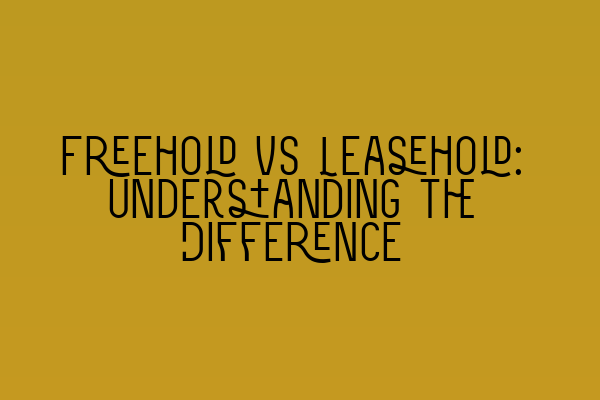Freehold vs Leasehold: Understanding the Difference
When it comes to property ownership, understanding the difference between freehold and leasehold is essential. Whether you are buying, selling, or investing in property, having a clear understanding of these terms will help you make informed decisions. In this article, we will explore the definitions, rights, and obligations associated with freehold and leasehold properties.
What is Freehold?
A freehold property is one that is owned outright by the occupant. This means that the owner has full ownership rights and control over the land and any buildings on it. Freehold ownership is often referred to as “ownership in perpetuity” because it is an indefinite and unrestricted form of ownership. Freehold properties are typically houses, bungalows, and some commercial properties.
With freehold ownership, the owner has the right to occupy the property for as long as they wish, subject to any legal restrictions or planning regulations. The owner also has the freedom to make alterations, extensions, or improvements to the property, as long as they comply with local building regulations.
Related Article: SQE 2 Preparation Courses
What is Leasehold?
Leasehold, on the other hand, refers to a property that is owned for a fixed period of time, usually for a term of several decades. When you purchase a leasehold property, you are essentially buying the rights to use and occupy the property for the duration of the lease. Leasehold properties are typically flats, apartments, and buildings within a larger development.
The land on which the leasehold property sits is owned by a separate entity known as the freeholder or landlord. As a leaseholder, you are required to pay an annual ground rent to the freeholder. The lease agreement will also outline any other charges, such as service charges for the maintenance and repair of communal areas in the development.
It’s important to note that the leasehold system can be complex, and the rights and obligations of leaseholders can vary. Before purchasing a leasehold property, it is advisable to seek professional advice to fully understand the terms and conditions of the lease.
Related Article: SQE 1 Preparation Courses
Key Differences between Freehold and Leasehold
Now that we have defined freehold and leasehold, let’s examine some key differences between the two forms of property ownership:
Ownership Duration
Freehold ownership is indefinite and everlasting, whereas leasehold ownership is for a fixed period of time as specified in the lease agreement. Typically, leaseholds last for several decades, but they can be shorter or longer based on the terms of the lease.
Responsibility for Maintenance and Repairs
For freehold properties, the owner is responsible for the maintenance and repair of the property. In contrast, for leasehold properties, the landlord or freeholder is responsible for the maintenance and repair of communal areas, while the leaseholder is typically responsible for the maintenance and repairs within their individual property.
Ground Rent and Service Charges
Leasehold properties generally require the payment of an annual ground rent to the freeholder. In addition, leaseholders may also be required to pay service charges to cover the maintenance and upkeep of communal areas. Freehold properties do not typically have these additional charges.
Which is Better: Freehold or Leasehold?
Deciding between freehold and leasehold ownership depends on your individual circumstances and preferences. Freehold ownership offers greater control and freedom over the property, while leasehold ownership provides the opportunity to live in certain types of developments and benefit from shared amenities.
If you are considering purchasing a leasehold property, it is essential to carefully review the terms of the lease, including the length of the lease, ground rent, service charges, and any other obligations or restrictions. Seeking legal advice can help you fully understand your rights and responsibilities as a leaseholder.
Related Article: SRA SQE Exam Dates
In Summary
Freehold and leasehold are two distinct forms of property ownership. Freehold provides indefinite ownership rights, while leasehold offers possession for a fixed period of time. Understanding the differences between freehold and leasehold will help you make informed decisions when buying, selling, or investing in property.
If you have any questions about freehold or leasehold properties, or if you require legal assistance with property law matters, please do not hesitate to contact us at SQE Property Law & Land Law.
Related Articles:
